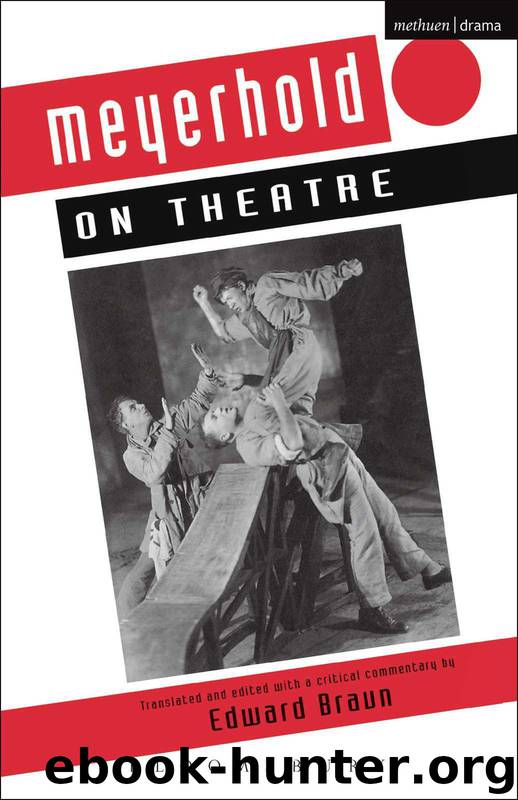Meyerhold On Theatre (Performance Books) by Vsevolod Meyerhold

Author:Vsevolod Meyerhold
Language: eng
Format: mobi
Publisher: BLOOMSBURY PUBLISHING
Published: 2014-04-30T16:00:00+00:00
1. Biomechanics
In the past the actor has always conformed with the society for which his art was intended. In future the actor must go even further in relating his technique to the industrial situation. For he will be working in a society where labour is no longer regarded as a curse but as a joyful, vital necessity. In these conditions of ideal labour art clearly requires a new foundation.
We are accustomed to the rigid division of a man’s time into labour and rest. Every worker used to try to expend as few hours as possible on labour and as many as possible on rest. Whereas such a desire is quite normal under the conditions of a capitalist society, it is totally incompatible with the proper development of a socialist society. The cardinal problem is that of fatigue, and it is on the correct solution of this problem that the art of the future depends.
In America at the present time much research is being devoted to the possible methods of incorporating rest in the work process instead of regarding it as a separate unit.
The whole question boils down to the regulation of rest periods. Under ideal conditions (taking account of hygiene, physiology and comfort) a rest of as little as ten minutes is capable of completely restoring a man’s energy.
Work should be made easy, congenial and uninterrupted, whilst art should be utilized by the new class not only as a means of relaxation but as something organically vital to the labour pattern of the worker. We need to change not only the forms of our art but our methods too. An actor working for the new class needs to re-examine all the canons of the past. The very craft of the actor must be completely reorganized.
The work of the actor in an industrial society will be regarded as a means of production vital to the proper organization of the labour of every citizen of that society.
However, apart from the correct utilization of rest periods, it is equally essential to discover those movements in work which facilitate the maximum use of work time. If we observe a skilled worker in action, we notice the following in his movements: (1) an absence of superfluous, unproductive movements; (2) rhythm; (3) the correct positioning of the body’s centre of gravity; (4) stability. Movements based on these principles are distinguished by their dance-like quality; a skilled worker at work invariably reminds one of a dancer; thus work borders on art. The spectacle of a man working efficiently affords positive pleasure. This applies equally to the work of the actor of the future.
In art our constant concern is the organization of raw material. Constructivism has forced the artist to become both artist and engineer. Art should be based on scientific principles; the entire creative act should be a conscious process. The art of the actor consists in organizing his material; that is, in his capacity to utilize correctly his body’s means of expression.
The actor embodies in himself both the organizer and that which is organized (i.
Download
This site does not store any files on its server. We only index and link to content provided by other sites. Please contact the content providers to delete copyright contents if any and email us, we'll remove relevant links or contents immediately.
| Acting & Auditioning | Broadway & Musicals |
| Circus | Direction & Production |
| History & Criticism | Miming |
| Playwriting | Puppets & Puppetry |
| Stage Lighting | Stagecraft |
Call Me by Your Name by André Aciman(20371)
Ready Player One by Cline Ernest(14524)
How to Be a Bawse: A Guide to Conquering Life by Lilly Singh(7391)
Wiseguy by Nicholas Pileggi(5671)
The Kite Runner by Khaled Hosseini(5083)
On Writing A Memoir of the Craft by Stephen King(4863)
Audition by Ryu Murakami(4850)
The Crown by Robert Lacey(4723)
Call me by your name by Andre Aciman(4619)
Gerald's Game by Stephen King(4581)
Harry Potter and the Cursed Child: The Journey by Harry Potter Theatrical Productions(4440)
Dialogue by Robert McKee(4321)
The Perils of Being Moderately Famous by Soha Ali Khan(4169)
Dynamic Alignment Through Imagery by Eric Franklin(4116)
Apollo 8 by Jeffrey Kluger(3637)
Seriously... I'm Kidding by Ellen DeGeneres(3577)
The Inner Game of Tennis by W. Timothy Gallwey(3575)
How to be Champion: My Autobiography by Sarah Millican(3555)
Darker by E L James(3477)
